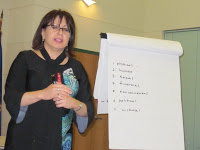Community development is all about ‘asset building’
 |
| Lopez |
At a forum on “building community” Thursday evening, sponsored by the Mason District Council, leaders from neighborhood groups cited some of the issues they’re concerned with: poorly maintained houses; hideous mcmansions; front-yard used car lots; never-ending renovation projects; and unwanted townhouse developments.
Presenters Elisa Lueck and Norma Lopez from the Fairfax County Office of Community and Neighborhood Services, advised neighborhood leaders to motivate residents to build a cohesive community by focusing on strengths, rather than problems.
Building community should be all about “asset building,” Lopez says. Assets are “the gifts, skills, and capacities of individuals, associations, and institutions within a community.” She defined community development as a “planned effort to build assets that increase the capacity of residents to improve their quality of life. It’s a process whereby community members come together to take collective action to resolve problems or take advantage of opportunities.”
The asset-based approach is all about looking at a glass as half full rather than half empty, Lopez says. The half-empty perspective looks at needs, while seeing a glass as half full focuses on assets.
Lopez asked the audience to list their communities’ needs and assets. Among the needs people mentioned were litter, lack of volunteers, and lack of public recreation places. The assets they identified included a diverse population, leadership, mature trees, and a tradition of community involvement.
You can mobilize people who are angry about a problem, but that is short term, Lopez says. “Giving hope, showing things neighborhoods are already doing, will organize communities for the long haul.”
Lueck described “asset mapping,” a process neighborhood associations can carry out to catalogue the resources in a community. The idea is to identify the capacities, gifts, and talents of individual residents, associations, and institutions. It’s a strength-based, rather than a needs-based, approach.
Once a community’s assets are identified, the next steps involve building relationships, developing a community vision and plan, and leveraging resources to support asset-based, locally defined projects and activities.
Asset-based community development focuses on participatory, inclusive, community-driven actions, where residents have a sense of ownership, along with “social capital,” which refers social relationships based on trust and norms that facilitate collective action. “Social cohesion is the glue that holds a community together,” Lopez says.
“The true work of the organizer is to focus on assets,” she says. “Be the one who tells the story of what is going right within your community. There might be problems, but there are also assets in your community. Focus on the positive.”

